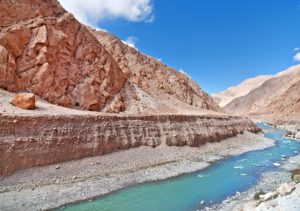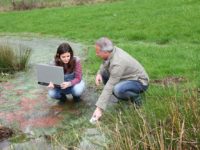
Sedimentologists study soil, sand and sediment of dry and wet land to extract data useful to industry and academic study.
What Does a Sedimentologist Do?
Sedimentologists are a type of geologist that examine certain rock types, but usually soil from a variety of areas (including sand and silt). Sediments exist in dry land, but usually in areas where there is a water table or a tidal flow such as salt marshes, rivers and lakes. They for a variety of things depending on where they work. They work in many different fields but look for inclusions. These inclusions could include contamination or pollutants. Those searching for toxic substances could work in government building legal cases against polluting companies or they could work for environmental agencies in explaining the problem and defining a potential cleanup operation. They are as likely to work in conservation as they are in government policy, just two of the possible decision making roles.
Some work in heritage, examining the ancient human past, looking for archaeological or paleontological evidence. The human impact and the spread of agriculture into an area can be fundamental to understanding its prehistoric and historic past in its wider context. Evidence of recent or ancient organic material (for example, pollen and spores) can provide a great picture of how a land type has changed over time. Archaeology of the landscapes of the world is a growing area and one we are just beginning to understand. Learn more about a stratigrapher career.
Many will also work for the petrochemical industries. We know that fossil fuels such as natural gas and crude oil exist in certain states, in certain places in specific rock types. Those who work in the petrochemical industry will be tasked with finding these fossil fuel sources and evaluating their viability. As oil pockets get fewer and harder to reach, we need Sedimentologists and other geology experts work together to mine for these materials efficiently and safely.
Most will spend their time moving between offices / labs and the field. This role will involve a lot of fieldwork to collect samples.
Where Does a Sedimentologist Work?
Unsurprisingly, the oil and gas industry employs the largest number of Sedimentologists. Employing a large number of geology professionals, they will work as a team to locate and harness sources of fossil fuel. Some 22%, that's just over one fifth of employees, work for oil and gas extraction. 30% of all geoscientists worked in Texas according to 2015 statistics, this includes sedimentologists.
17%, or around one sixth, worked in Engineering Services. In this type of role, they provide either independent advice for environmental engineering or construction, for example. They may also provide advice on conservation and land restoration - anything where land changes or building work is required.
15% worked in management, scientific and technical consulting services. They may provide advice on restoration and conservation, or be hired simply to take readings for specific projects. Usually, these people work third party.
8% worked for state government, typically in conservation or ensuring legal compliance for local users (businesses and individual use). They may also be involved in direct conservation.
7% worked in academia. They may work in teaching roles or in research. Their potential scope is broad, but usually within Earth Science departments (geography, geology, paleontology, anthropology).
What Is the Average Sedimentologist Salary?
According to the BLS, the median salary for sedimentologists, who fall under the BLS category of geoscientists, was $93,580 as of May 2020. The lowest 10% earned about $51,890, and the highest 10% earned about $201,150. Naturally, oil and gas extraction paid the highest median at $125,670 - way above the median.*
Sedimentology Jobs & Job Description
A sedimentologist at the beginning of his or her career must have a strong knowledge base of geological and sedimentological principles and be able to apply this knowledge to analysis and core description relevant to his or her industry (e.g., oil & gas, environmental engineering, etc.). Day-to-day job duties may include:
- Conduct detailed sedimentological investigations and analyze the quantity and distribution of sedimentary rocks
- Collect and analyze rock samples collected in sedimentological surveys and draw conclusions to be presented
- Determine the most suitable means of safely extracting ore and sedimentary minerals
- Write reports, maps and technical documents and present papers to help plan environmental programs and resource management
- Use sophisticated computer programs to interpret data sets of geological information
- Development of exploration models and 3D static geological models
A more senior sedimentologist may add leadership tasks to his or her job description, including mentoring more junior team members and providing quality control across various projects. His or her job description includes much of the above, as well as:
- Mentor junior staff team members and ensure knowledge sharing across project teams within the organization
- Provide sedimentology advice and project input to management and various project teams across the organization
- Provide detailed core description and quality control of any consultant's or contractor's core descriptions
- Development of best practice policies for sedimentology
- Establish and maintain relationships with academia and external experts in the sedimentology industry
- Keep up-to-date on new advances in sedimentology in industry and academia and incorporate those learnings into organization's projects as applicable
What Is the Job Demand for Sedimentologists?
This is a growing area with an expected job growth of 7% between 2020 and 2030. The reason for this is the increased specialization required in the oil and gas industry as petrochemicals become increasingly difficult to find and access. Also, the growing need for environmental protection in light of the oil and gas industry's shifting priorities means that geoscientists will also increasingly work in conservation and restoration.*
What Are the Education Requirements to Become a Sedimentologist?
Geography will be the backbone of this career for high school students. Physics and chemistry may also be required. Math and English language will certainly be necessary. Colleges will look for a good grounding in the natural sciences in your application.
Students should ideally seek degrees in geology where available, or to geography and tailor their studies around earth sciences rather than climate or human geography. Minors and electives should support the application for further study. Physics, chemistry and math are ideal supporting subjects, Students who prefer environmental protection type roles should study Earth sciences such as environment and conservation. Paleontology or archaeology may be useful supporting subjects where available.
Bachelor's degrees should be suitable for most entry jobs, but for those seeking promotion and greater responsibility - including project management and research positions, you should seek a master's degree. Statistical analysis and data analysis are parts of postgraduate courses not generally utilized with undergraduate degrees. Students seeking academic positions and research should certainly pursue postgraduate study (including Doctorates) as far as possible.
Sedimentology - Related Degrees
What Kind Of Societies and Professional Organizations Do Sedimentologists Have?
Sedimentology is a growing area. The following representative groups are available.
- International Association of Sedimentologists: The IAS is the largest body of its kind, representing the global community in developing standards and promoting the sub-discipline within the science of geology
- Society for Sedimentary Geology: Another global body, SEPM organizes annual conferences to push the boundaries and promote the science. They allocate annual awards for research in the field and make available a number of grants
*2020 US Bureau of Labor Statistics salary figures and job growth projections for geoscientists reflect national data not school-specific information. Conditions in your area may vary. Data accessed September 2021.





